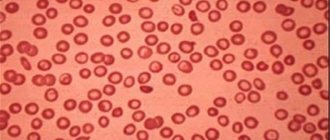The condition when red blood cells are found in the urine of pregnant women is called hematuria in medicine and is not the norm. This may be a sign of a serious illness or a consequence of physiological changes temporarily present in the female body.
To determine the reasons for blood getting into the tests, additional examination methods are prescribed in the form of ultrasound and consultation with specialists. If the condition is accompanied by clinical manifestations of inflammation, or the urine has a pronounced red color, the woman is hospitalized and prescribed bed rest until the diagnosis is clarified.
Etiology
Erythrocytes are red blood cells responsible for transporting oxygen to tissues. Normally, these blood cells are not detected in a general urine test. A slight increase in this indicator may be due to functional changes in the genitourinary system of a pregnant woman, caused by the pressure of the expanding fetus in the 3rd trimester on the organs of the excretory system. The presence of anemia of various origins in a patient with the appearance of such cells in the urine indicates the development and progression of the pathology.
In 70% of cases, erythrocyturia at different stages of gestation is a consequence of natural physiological processes and changes occurring in the body of a pregnant woman. Depending on the clinical symptoms and the results of additional laboratory tests, medical personnel determine the exact reason why red blood cells appear in the urine during pregnancy.
The following types of this pathology are distinguished depending on the etiology:
- False hematuria. The appearance of red blood cells in the analysis results is caused by changes unrelated to inflammatory diseases of the excretory tract.
- True erythrocytouria is a clinical symptom associated with acute or chronic inflammatory and infectious changes.
Physiological changes
The increasing volume of the uterus affects the bladder, partially obstructs the outflow of urine in later stages of gestation and contributes to the appearance of minor bleeding. Blood in the urine during pregnancy can be a consequence of hormonal changes in the body. This type of hematuria is classified as idiopathic or primary.
Changes in the color of urine can also be caused by the consumption of certain foods (beets, rhubarb, cherries, blackberries, drinks with food coloring). Some medications (Riboflavin, Aspirin, Ibuprofen, phenolphthalein derivatives) can give urine a red color.
Pathological processes
Sometimes the appearance of red blood cells in the urine is a marker of the development or progression of pathologies of various localizations:
- Acute or chronic cystitis - inflammation of the bladder;
- Pyelonephritis is an inflammatory process of the renal pelvis;
- Infectious processes of the pelvic organs;
- Complications of diabetes mellitus - significant impairment of glomerular renal filtration;
- Urolithiasis disease;
- Autoimmune diseases that cause damage to local capillaries in the excretory tract (for example, systemic lupus erythematosus).
- Mechanical damage to organs and tissues;
- Cervical erosion, vaginitis or colpitis, accompanied by minor bleeding;
- Sexually transmitted infections;
- Macrohematuria as a consequence of placental abruption.
What is the danger of an increase in red blood cells in urine tests and what to do
Hematuria itself does not harm the health of the pregnant woman and the unborn baby. But the condition is a symptom of various diseases that cause serious complications. So, blood in the urine may appear due to rare pathologies:
- thrombocytopenia;
- disorders of the blood clotting mechanism;
- hereditary diseases of blood vessels and connective tissue;
- injuries to internal organs.
Therefore, you need to immediately undergo an examination that will identify the cause and make it possible to start treatment in a timely manner.
During the period of bearing a child, any independent actions to eliminate hematuria are strictly prohibited. Therapy is carried out under the supervision of specialists who prescribe treatment of concomitant diseases with approved drugs.
According to statistics, in most women, red blood cells appear in the urine in small quantities, are not a sign of serious illness and do not threaten the course of pregnancy. If hematuria has developed not against the background of pathology, but due to external factors or fatigue, to normalize the tests, it is enough to take a break from physical labor and calm down. Doctors recommend taking valerian, drinking mint tea and walking more.
Associated symptoms
Signs of a pathological process in a pregnant woman’s body depend on the etiology of the symptoms. Most often, with hematuria of varying severity, the following clinical signs appear:
- Pain localized in the lumbar back, projection of the kidneys. Often, unpleasant sensations radiate to the lower abdomen and perineum.
- Burning during urination.
- An increase in body temperature to subfebrile or febrile levels is a reliable sign of an inflammatory process.
- Vomiting and nausea are a consequence of pain impulses and hyperthermia.
- Change in color of urine. Depending on the number of blood cells, the color varies from light pink to black, and blood clots may appear.
Classification
Hematuria comes in two main types: micro- and macrohematuria. In the first case, the admixture of blood in the urine is insignificant and not visible to the naked eye. In this case, the level of red blood cells does not exceed 4 pcs. When examining a sample according to Nechiporenko, no more than 1000/l of red blood cells will be found.
Gross hematuria turns urine dirty red, dark brown and even black due to the high concentration of red blood cells.
Depending on the manifestations, hematuria is classified into the following types:
- persistent – observed for a certain period, the color and composition of urine does not change;
- recurrent - the level of red blood cells fluctuates, sometimes increases, sometimes decreases to normal values;
- isolated - in the urine there is only an admixture of blood without the presence of other pathological components - protein, high concentration casts, leukocytes, etc.;
- painful – accompanied by pain in the urinary organs and/or lower back. There may be painful urination or constant pain in the lower back while going to the toilet without pain. Both options are also found;
- painless - an asymptomatic form that does not affect the condition of the pregnant woman in any way;
- hematuria + proteinuria - in addition to red blood cells, protein and other elements characteristic of inflammation in the urinary tract are found in the urine.
With microhematuria, the number of red blood cells does not exceed 50
Based on the localization of pathological changes, hematuria is classified into post-renal and renal. In the first case, the problem is in the urinary tract, in the second, it is localized exclusively in the kidneys.
In addition, hematuria is divided into true and false. The true variety is associated with chronic or acute pathologies of infectious and inflammatory origin. The causes of false hematuria have no connection with damage to the urinary organs.
Features of diagnosis in pregnant women
Gross hematuria in pregnant women often occurs without the manifestation of additional symptoms. Therefore, for timely diagnosis of pathological changes in the body, it is necessary to regularly monitor the indicators of a general urine test.
The frequency of monitoring the composition of urine depends on the timing of gestation. In the 1st-2nd trimester, the test is prescribed once a month, preferably before a scheduled visit to the antenatal clinic. In the last three months of pregnancy, it is advisable to conduct laboratory tests every two weeks. If deviations from established standards are detected, the patient is prescribed a control analysis.
If the data is confirmed, the doctor may recommend additional laboratory and instrumental diagnostic methods:
- General blood analysis. The presence of an inflammatory process may be indicated by an increase in the erythrocyte sedimentation rate (ESR) and leukocytosis. True anemia is a reliable sign of internal bleeding.
- Ultrasound diagnostics of the genitourinary system. Using ultrasound, you can diagnose anatomical changes in the structure of organs or tissues.
Methodology
A general analysis of biological fluid is an effective diagnostic method for reliably determining red blood cells in the urine of a pregnant woman. For this type of study, the patient provides the laboratory with a portion of morning urine, collected in a special dry container with a sealed lid for safe transportation. In addition to the material being studied, it is necessary to provide the medical personnel with a completed referral from the attending physician.
To obtain diagnostic results, the laboratory technician determines the following basic indicators of urine and its composition:
- Color and transparency.
- Acidity.
- Determination of protein and its traces in a laboratory specimen.
- Ketone bodies, which are an objective sign of protein metabolism disorders.
- Test for the presence of sugar (glucose).
- Physical determination of the relative density of a material.
- Detection of blood cells (erythrocytes or leukocytes).
- Presence of salt deposits or epithelial cells.
Collection rules
There are several simple rules, the observance of which will help to obtain the most reliable research result:
- On the eve of the test, it is not recommended to consume spicy and salty foods, take alcohol and various medications, or abuse mineral water - this may negatively affect the reliability of the diagnostic test.
- The minimum required volume is 100 ml.
- It is preferable to collect urine in special industrial sterile containers sold in the pharmacy chain.
- It is necessary to collect urine immediately after waking up from a night's sleep. The functional features of the excretory process ensure the maximum concentration of the morning portion, which will make it possible to diagnose the slightest changes in composition.
- For analysis, it is necessary to select the middle part of the total volume, having previously performed hygienic treatment of the perineum with soap and running water.
- To prevent distortion of the results, it is advisable to cover the vaginal entrance with a cotton swab.
- The sooner the test liquid is delivered to the laboratory, the more accurate the data obtained will be. General recommendations for all laboratory organizations, regardless of their form of ownership: from collection to delivery, no more than 2 hours should pass.
Types of hematuria
The type of hematuria is determined by the cause that led to the development of this syndrome:
- Extrarenal : the appearance of blood in the urine is not associated with diseases of the urinary system and injuries.
- Renal : hematuria is caused by kidney pathology.
- Postrenal : the syndrome occurs as a result of diseases of the urinary tract and bladder.
Classification of hematuria according to the degree of development of the syndrome:
- Terminal : blood is contained in the last portion of urine.
- Initial : blood is detected in the first portion of urine.
- Total : a portion of urine has a scarlet tint.
If the patient's urine is completely red, we can judge the presence of gross hematuria.
Decoding laboratory data
A thorough study of the results of a diagnostic study and the establishment of a reliable diagnosis should be carried out exclusively by the attending physician or gynecologist who is seeing the pregnant woman.
The table below describes the main studied properties of urine and acceptable values for pregnant women, regardless of gestational age.
| Index | Norm |
| Color shade | Light yellow, straw |
| Transparency characteristic | Transparent |
| Smell | Characteristic of a given biological fluid, unsharp |
| Protein and its traces | Absent. Critical value - 0.33 g/l |
| Glucose | 0-0.083 mmol/l |
| Bilirubin | — |
| Ketone bodies | Not defined |
| Leukocytes | 0-5 |
| Red blood cells | Less than 3 |
| Bacteria, fungi | — |
| Salts | Not detectable or in small quantities |
| Slime | Not rendered |
| Specific gravity | Ranges from 1003 to 1035 |
| Acidity of the environment | pH 5.0-7.0 |
The most important indicators for determining hematuria are counting the number of red blood cells visible in the field of view of the laboratory technician. If more than 3 red blood cells are detected in the test product, this indicates the presence of erythrocyturia of varying intensity and the need for additional diagnostic methods.
Glomerulonephritis
This is a bilateral inflammation of the kidneys, predominantly affecting the glomeruli of the kidneys (small vessels). With this disease, the basic functions of the kidneys are disrupted: the formation of urine and the removal of toxic and unnecessary substances from the body. The incidence of glomerulonephritis among pregnant women is about 5-7%.
The causes of this disease are most often: chronic tonsillitis, meningococcus, pneumococcus, staphylococcus, viridans streptococcus, hepatitis B virus, salmonella, viruses of acute respiratory diseases. In pregnant women with glomerulonephritis, proteinuria is observed from 0.036 g/l to 30 g/l. Sometimes, especially in the second half of pregnancy, when acute glomerulonephritis appears, it can initially be mistaken for gestosis, since its symptoms are similar: severe swelling of the entire body and high blood pressure. But, as a rule, test results clarify the situation.
Treatment of glomerulonephritis during pregnancy is carried out exclusively under the supervision of doctors and includes: taking a course of antibiotics allowed during pregnancy, treating edema and hypertension, and maintaining kidney function until they are completely restored.
Treatment
It is important to know! Hematuria is not a diagnosis, but one of many clinical symptoms. Therefore, for treatment to be effective, it is necessary to accurately determine the reasons for the appearance of red blood cells in the urine.
An increased content of red blood cells in urine is a reason for a pregnant woman to immediately seek advice from her doctor to prescribe additional diagnostic procedures and adequate drug correction of this condition.
A feature of therapeutic tactics during pregnancy at any stage of gestation is the impossibility of using certain medications that can adversely affect the mother’s body or fetus. The choice of medications should be made taking into account the expected benefits for the mother and the acceptable risk of using the medicine for the unborn child. If a pathology of the genitourinary system is detected, inpatient treatment in a specialized medical institution is recommended.
Etiological
The selection of necessary medications and calculation of their dosage are made taking into account the etiology of the appearance of hematuria in the patient’s laboratory analysis.
If a change in the clinical parameters of the analysis is caused by internal bleeding, medications from the group of hemostatic agents are prescribed: “Vikasol”, “Dicinone”, “Aminocaproic acid”.
If there are infectious processes in the excretory system or pelvic organs, adequate anti-inflammatory therapy and broad-spectrum antibiotics are prescribed, which are acceptable for use during pregnancy.
It is allowed to prescribe renal herbal preparations and medications based on medicinal herbs, which are not contraindicated for pregnant women. Most often, to quickly relieve inflammation, expectant mothers are prescribed the effective drug Canephron.
Attention! In cases where hematuria is caused by a manifestation of urolithiasis, and spontaneous passage of the stone from the ureter is impossible, there is a need for urgent surgical treatment. In this case, the main struggle is aimed at preserving the patient’s life.
What tests can be prescribed?
24 hours before donating urine, pregnant women should exclude coloring foods from their diet and not take vitamins. Tablets are taken only if necessary and after consulting a gynecologist.
In the morning before the procedure, you should hygienically wash the perineal area without soap or gels. You need to collect the analysis in a clean jar or special pharmacy container. The vagina should be covered with a tampon, the anus should also be covered if there are cracks in the rectum.
- General analysis and additional research on Nechiporenko. A sterile container is not required, just rinse the dishes with soda. You should start and finish urinating in the toilet. Only the middle portion is collected into the container. An increase in the content of red blood cells during pregnancy is a reason to prescribe a study according to Nichiporenko. It is carried out with the aim of separately counting red cells per 1 mm of urine sediment in a cube.
- Zimnitsky test. This test is prescribed for true hematuria to diagnose kidney damage in pregnant women. Urine must be collected every three hours in a separate container. A total of 8 labeled containers need to be submitted to the laboratory. During the Zimnitsky study, all urine per day is collected. If it does not fit in a certain container, take an additional one and indicate the time on it.
- Bacteriological analysis. It is prescribed to confirm the infectious process in the urinary system and to identify the pathogen. The material is collected strictly in sterile containers. An average portion of morning urine is taken. The container is tightly closed and sent to the bacteriological laboratory.
- Three-glass sample. Erythrocyte formulas in different portions of urine help determine where the source of bleeding is located. This is either the urethra, or the kidneys, or the bladder. You need to collect the analysis in three different containers at a time. Based on the results, the doctor prescribes treatment for the affected area.
Symptomatic therapy
To alleviate the patient’s condition caused by pathological processes in organs and tissues, adequate symptomatic treatment is prescribed.
- To relieve spasms from the urethra and ureter, antispasmodic drugs “Spazmolgon”, derivatives of drotaverine (“No-shpa”), “Papaverine” are prescribed.
- To relieve pain, the following pharmaceuticals are used: analgesics (“Tramal”, “Analgin”), it is possible to prescribe narcotic drugs under the strict supervision of medical personnel (“Promedol”).
Relatively safe medications based on paracetamol or ibuprofen (Nurofen, Panadol, Efferalgan) can be used as antipyretics during pregnancy.
Depending on the severity of the patient’s condition and the individual clinical situation, various forms of drugs are used: parenteral, intramuscular or intravenous administration.
Signs by which hematuria is determined
It is quite difficult to determine the presence of microhematuria by any characteristic signs, since most often it is asymptomatic, therefore, for the purpose of prevention, pregnant women need to have their urine analyzed monthly. Timely completion of the necessary laboratory tests allows us to identify the presence of the syndrome in the early stages, which greatly simplifies the treatment process.
Discomfort and pain during urination may indicate pathology of the kidneys or organs of the genitourinary system. Most often, such ailments are accompanied by unilateral lumbar pain.
A patient with hematuria may experience symptoms such as:
- loss of appetite;
- nausea;
- vomit;
- deterioration in general health;
- headache;
- lack of weight gain during pregnancy.
The absence of characteristic signs of a high content of red blood cells in the urine significantly complicates the process of identifying the presence of the syndrome in a patient.
Hematological complications during pregnancy
- Iron-deficiency anemia.
- Thrombocytopenia.
- Neonatal alloimmune thrombocytopenia.
- Acquired hemophilia A.
- Venous thrombosis.
- Rh and non-Rh alloimmunization. For diagnosis, an analysis is performed for Rh antibodies and anti-group antibodies.
- The manifestation of a previously unrecognized disorder of the coagulation system, such as von Willebrand disease, most often manifests itself in women during pregnancy and childbirth. To screen for von Willebrand disease, a test is performed to evaluate platelet aggregation with ristocetin.
- Aplastic anemia.
Tags:
complete blood count, anemia, pregnancy, iron, platelets, erythrocytes, leukocytes
Back to section
Tests for hematuria
If hematuria is suspected, a woman should undergo a urine test. When collecting urine, you must strictly follow the prescribed rules to avoid distortion of the results.
Urine collection algorithm:
- In the morning after bathing procedures, you need to prepare a gauze swab.
- Next, you need to place the tampon in the vagina and release the first portion of urine.
- It is necessary to collect the remaining urine in a previously purchased container, making sure that the container body does not touch the skin.
- For analysis, you need to collect 70 milliliters of urine.
- If the test result shows that the expectant mother's urine contains a large number of red blood cells, she will need to undergo a repeat laboratory test and visit a gynecologist.
The inspection consists of the following procedures:
- examination of the cervix using a gynecological speculum;
- microscopic examination of the mucous membrane;
- laboratory smear examination;
- carrying out bacteriological culture;
- Ultrasound of the kidneys;
- urine examination for the level of leukocytes, red blood cells and casts.
Some types of diagnostic tests are carried out only after childbirth, since they can harm the health of the unborn baby. These include:
- CT scan;
- thyroid scan;
- excretory urography.
The results of the examination allow the doctor to determine the exact cause of the content of red blood cells in the urine of the expectant mother and prescribe appropriate treatment. Regular laboratory tests help prevent pregnancy pathologies, miscarriages and diseases of the urinary system.











